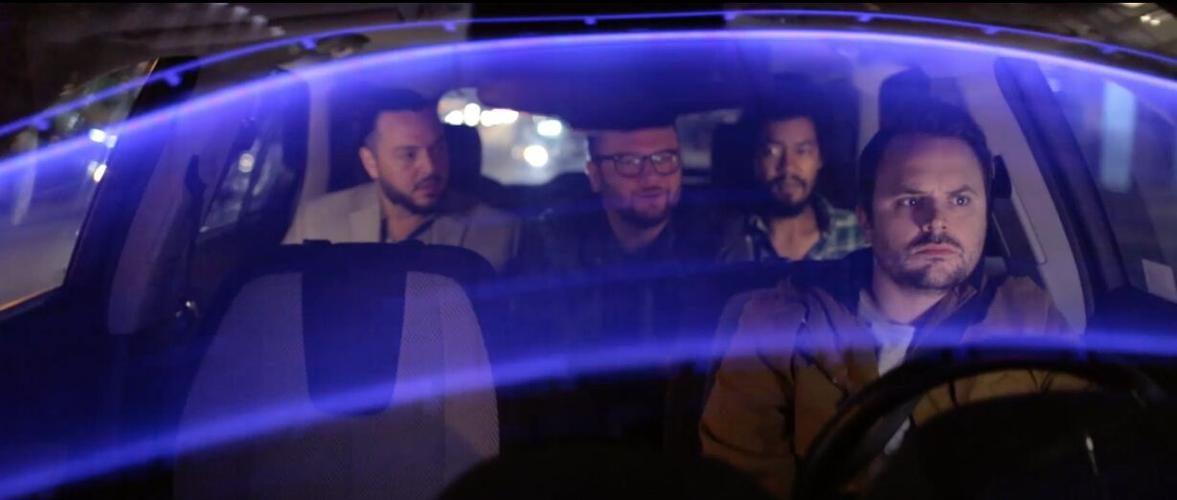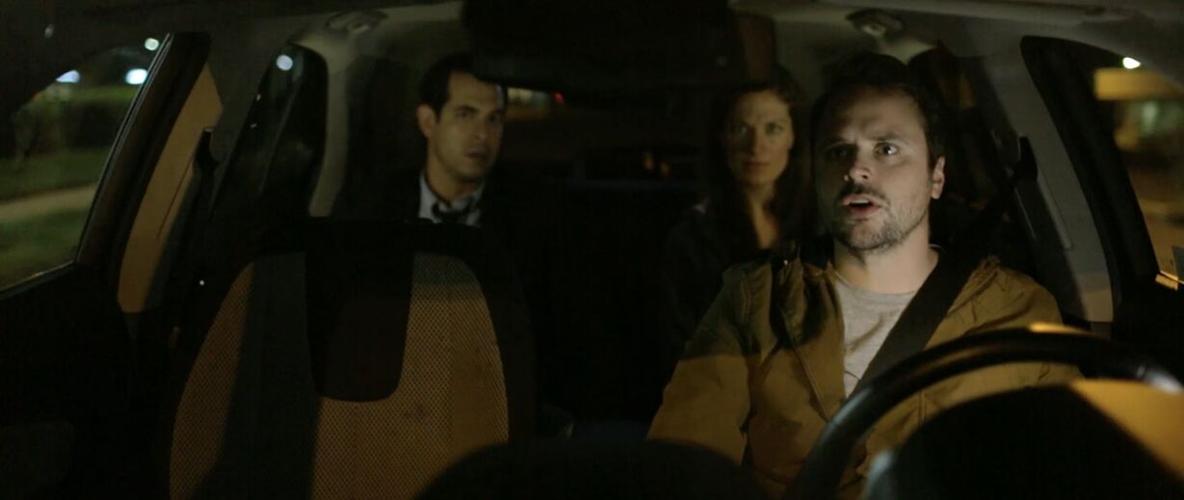The feature debut of Thomas Torrey who writes, directs and stars is notable because it was filmed in three days, almost completely in a car, a silver, Chevy SUV to be exact. The only exceptions are the opening and closing shots, as well as angles from a camera attached to the surface of the car. Other than that, the whole movie takes place inside the SUV.
Ever since the late 1960’s and early 70’s, films that take place inside cars and often on the open road have become a genre in and of themselves. One of the greatest examples is George Lucas’ American Graffiti (1973), which explores youth culture as through the excitement of a revving engine on four wheels. Most though are more about the road trip and not necessarily the experience inside the car. Examples include comedies like National Lampoon’s Vacation (1983) or crime dramas like Thelma & Louise (1991). Thrillers like Steven Spielberg’s Duel (1971) or action films like Mad Max: Fury Road (2015) do try to limit the experience to being only inside the car as it rolls from here to there.
Yet, those aforementioned films still embrace the outside world, if even in small measure, and are in various ways commentaries on the outside world. It’s only within the past five years that these road-trip or car films have gotten more insular and more inward-looking, or more egotistical. Like found-footage films, these new road-trip movies literally trap their characters and the audience within the automobile, almost as if the confines of the car represent the confines of the mind.
The first expression I remember was the highly-overlooked thriller Vehicle 19 (2013), which starred the late Paul Walker. Next was the British drama Locke (2014), which starred Oscar-nominee Tom Hardy, and last year was the experimental film from Iran, Jafar Panahi’s Taxi (2015). All three of those films are confined to their cars. Panahi’s Taxi is the only one that maintains some sense of what’s going on beyond the car-doors. It’s not as agoraphobic as the other two or arguably this one.
Torrey’s film is somewhere between Vehicle 19 and Locke in that it focuses on a white man dealing with relationship problems. It actually leans more toward Locke as the man handles an adulterous affair, not an affair perpetrated by him though. The film then pivots toward Vehicle 19 as the man handles the possible threat of death and seeming survival. It’s a pivot that’s perhaps not as graceful. It’s a tonal shift that’s a bit jarring as the whole thing veers into horror-film territory, but still this movie is somewhere between that Paul Walker flick and the Tom Hardy solo-act.
Torrey’s script has a lot of pseudo-philosophizing, which honestly comes across as babbling, but about 20 minutes into it, a genuine conversation about the nature of marriage breaks out as two characters debate who can be or is to blame when an affair occurs. Unfortunately, Torrey decides after that to drive the screenplay toward psychopathy and plot-contrivances that make his characters seem stupid or unsympathetic. The movie then moves further and further away from reality and responsibility, as much as it moves further and further away from Charlotte, North Carolina, its initial setting.
Torrey as the central actor neither possesses the charm of Paul Walker nor the gravitas of Tom Hardy. Walker’s character in Vehicle 19 is an ex-con and Hardy’s character in Locke is a philanderer. Yet, Walker and Hardy manage to make their characters vastly more likeable than Torrey does his self-performing protagonist who is simply a cuckold. His depressive to then manic, emotional swing also isn’t endearing. He could almost get away with it if his character were bipolar, but that doesn’t seem to be the case.
The pseudo-philosophizing attempts to examine the idea of love and Torrey’s narrative twists in the final act attempt to prove something. However, what that something is gets lost in the “devil ex machina” that is the final fifteen minutes of this movie.
Thomas Torrey plays Eric Hollister, the aforementioned cuckold who has a job in real estate but supplements his income by driving his car as a taxi, utilizing a ride-sharing app like Uber or Lyft. Some unanswered questions include the following. Why does the older guy with the Irish accent sit upfront in the taxi but everyone else sits in the back, even three club-hoppers who seem uncomfortably squished together? When Audrey, played by Katherine Drew, opens the door, why doesn’t Patrick, played by J. R. Adduci, get out the car then? And, when horror breaks out at the end, why doesn’t Eric tell Audrey what he saw?
Like found-footage films, the answers to these questions seem to be because the characters have to stay inside the car. This becomes a case of style trumping substance. It’s laughable in many of the most recent found-footage films. It’s frustrating here. It reeks of the whole production being more of a gimmick that loses logic-sustainability or suspension-of-disbelief as it speeds toward its conclusion.
Three Stars out of Five.
Not Rated but contains adult language.
Running Time: 1 hr. and 15 mins.
World Premiere on April 26 at the Newport Beach Film Festival.
For more information, go to faremovie.com.






























